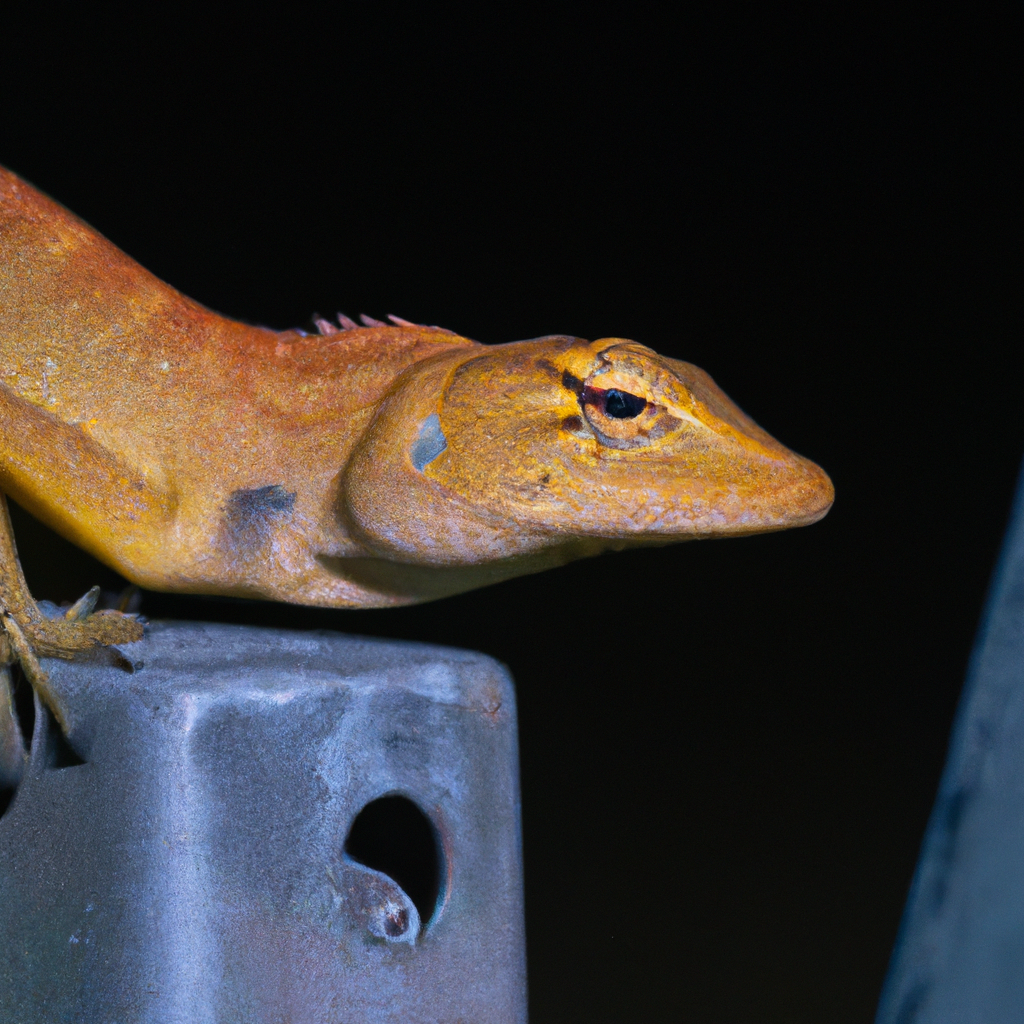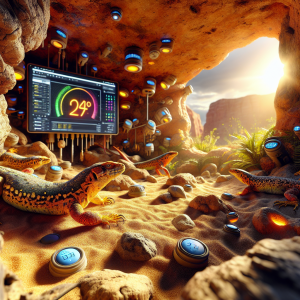Understanding the Importance of Temperature and Humidity Control for Lizards
In the world of pet care, ensuring the right temperature and humidity levels for our scaly friends is crucial. Picture this: you’ve just brought home a new lizard buddy, full of excitement and curiosity. You want to create a cozy, safe habitat for them to thrive in, right? Well, my friend, that’s where the magic of understanding lizard temperature and humidity control comes into play!
Let me share a fascinating fact with you – did you know that lizards are ectotherms, meaning they rely on their environment to regulate their body temperature? Yep, they need the perfect balance of warmth and humidity to stay healthy and happy. It’s like having your very own tiny climate control system at home!
Now, here’s the kicker – getting it just right can be a bit tricky at first. It’s not just about tossing in a heat lamp and a water bowl; it’s about creating a mini ecosystem that mimics their natural habitat. You’ll need to consider factors like the type of lizard you have, the size of their enclosure, and the best heating and humidity sources to keep them comfortable.
Let me ask you this: have you ever wondered why some lizards bask under a heat lamp all day while others prefer to hide in cool, damp spots? Understanding these behaviors and preferences can help you tailor their habitat to suit their needs perfectly. It’s like being a lizard whisperer, decoding their unique language of comfort and well-being.
As we dive deeper into the world of lizard temperature and humidity control, we’ll explore practical tips, DIY tricks, and recommended products to make your lizard’s home the envy of all reptiles. So, buckle up, my friend, because we’re about to embark on a journey to create the ultimate lizard paradise right in your own home!
Factors to Consider When Setting Up a Habitat for Pet Lizards
So, when it comes to setting up a habitat for your pet lizards, there are a few factors you need to keep in mind. Did you know that different species of lizards have specific temperature and humidity requirements based on their natural habitats? It’s fascinating to think about how these small creatures have adapted to thrive in various environments around the world. Understanding these factors is crucial for creating a comfortable and healthy living space for your scaly friends.
When considering the habitat setup for your pet lizards, you’ll want to think about factors like the size of the enclosure, the type of substrate used, and the placement of heat sources. These elements all play a role in maintaining the right temperature and humidity levels for your lizards. It’s like creating a mini ecosystem within your home!
One interesting aspect to consider is the thermal gradient within the enclosure. Lizards, like many reptiles, are ectothermic, meaning they rely on external heat sources to regulate their body temperature. By providing a gradient of temperatures within the enclosure, your lizards can choose the spot that best suits their needs at any given time. This mimics their natural behavior in the wild, where they move between sunny and shaded areas to regulate their body temperature.
Another fun fact to keep in mind is that humidity levels can vary depending on the species of lizard you have. Some lizards, such as bearded dragons, require lower humidity levels, while others, like chameleons, need higher humidity to thrive. Understanding the specific needs of your lizard species is essential for creating a habitat that supports their health and well-being.
By taking these factors into account and providing the right conditions for your pet lizards, you can ensure they are happy, healthy, and thriving in their environment. It’s all about creating a cozy home that meets their unique requirements and allows them to exhibit their natural behaviors.
Choosing the Right Heating Solutions for Optimal Temperature Regulation
You know, when it comes to setting up the perfect habitat for your pet lizard, choosing the right heating solutions is crucial. It’s like finding the Goldilocks of heating options—not too hot, not too cold, but just right.
One practical tip that I’ve found super helpful is to opt for under-tank heating pads or heat mats. These are great for providing a gentle, consistent heat source from below, mimicking the warmth lizards would feel in their natural environment. Plus, they’re easy to install and can be controlled with a thermostat to maintain the ideal temperature range for your scaly friend.
Another heating solution to consider is ceramic heat emitters. These emit infrared heat without light, which can be beneficial for lizards that require warmer temperatures but still need a day-night cycle. Just make sure to pair them with a thermostat to prevent overheating and ensure your lizard’s comfort.
And let’s not forget about heat lamps! These are perfect for basking areas, allowing your lizard to thermoregulate by moving between warmer and cooler zones in their enclosure. Remember to position the heat lamp at a safe distance to avoid any burns.
By combining these heating solutions strategically in your lizard’s habitat, you can create a cozy and balanced environment that meets their specific temperature needs. It’s all about finding that sweet spot where your lizard can thrive and feel right at home. So, when it comes to temperature control for your scaly buddy, a little warmth goes a long way!
Maintaining Proper Humidity Levels for Lizard Health and Comfort
Let me tell you about maintaining proper humidity levels for your pet lizards. It’s crucial for their health and comfort, just like how we humans need the right environment to thrive. Have you ever considered how humidity affects these fascinating creatures? It’s truly fascinating.
Imagine this: you’re a lizard basking in the warmth of your habitat. You rely on the humidity levels to keep your skin hydrated and aid in shedding. Just like us when we moisturize our skin, lizards need the right balance to stay healthy.
Did you know that different species of lizards have varying humidity requirements? Some prefer a drier environment, while others thrive in more humid conditions. It’s essential to research your specific lizard’s needs to create the ideal habitat for them.
Now, here’s a practical tip for you: misting your lizard’s enclosure regularly can help maintain proper humidity levels. By spraying water on the substrate and plants, you can create a humid environment that mimics their natural habitat. Just be careful not to overdo it, as too much moisture can lead to mold growth and respiratory issues.
Have you ever wondered what challenges lizard owners face when trying to control humidity levels? It can be tricky to strike the right balance, especially in areas with fluctuating weather patterns. But with the right tools and knowledge, you can provide a comfortable and healthy environment for your scaly friend.
So, next time you’re setting up your lizard’s habitat, remember the importance of humidity control. It’s not just about creating a cozy space; it’s about ensuring their well-being and happiness. Proper humidity levels can make a world of difference for your pet lizard’s overall health.
Common Mistakes to Avoid in Lizard Temperature and Humidity Control
Let me tell you about the common mistakes to avoid in lizard temperature and humidity control. Picture this: you’ve spent hours researching the best heating and humidity solutions for your pet lizard, meticulously setting up the perfect habitat, only to realize that you’ve unknowingly made some critical errors that could harm your scaly friend.
One common mistake that many lizard owners make is overlooking the importance of proper ventilation in the enclosure. While it’s essential to maintain the right temperature and humidity levels, inadequate airflow can lead to stagnant air and the buildup of harmful bacteria and mold. This can have serious consequences for your lizard’s respiratory health, so ensuring good ventilation is key.
Another mistake to avoid is using the wrong type of substrate in your lizard’s enclosure. Some substrates, like sand or cedar shavings, can be harmful if ingested and may also impact humidity levels in the enclosure. Opting for safe substrates like coconut fiber or reptile carpet not only provides a comfortable surface for your lizard but also helps maintain proper humidity levels without posing health risks.
Additionally, a common oversight is improper placement of temperature and humidity monitoring devices. Placing thermometers and hygrometers in inaccurate locations within the enclosure can lead to misleading readings, resulting in ineffective temperature and humidity control. It’s crucial to position these devices where your lizard spends most of its time to ensure accurate monitoring and adjustment.
By avoiding these common mistakes and paying attention to the details of temperature and humidity control in your lizard’s habitat, you can create a safe and comfortable environment that promotes your pet’s well-being. Remember, small adjustments can make a big difference in providing the ideal living conditions for your scaly companion.
Best Practices for Monitoring and Adjusting Temperature and Humidity Levels
Let’s dive into the exciting world of monitoring and adjusting temperature and humidity levels for our beloved pet lizards. Picture this: you’re setting up your lizard’s habitat, making sure everything is just right. The temperature needs to be warm enough to keep your scaly friend cozy, but not too hot to cause discomfort. Humidity levels are crucial too, especially for species that require higher moisture in the air. It’s like creating a mini ecosystem right in your living room!
Now, here’s an interesting fact for you: did you know that different species of lizards have specific temperature and humidity requirements? For instance, desert-dwelling lizards like bearded dragons prefer a hot and dry environment, while tropical lizards such as green anoles thrive in warmer and more humid conditions. Understanding these unique needs is essential for providing the best care for your pet lizard.
When it comes to monitoring and adjusting temperature and humidity levels, the key is consistency. Fluctuations can stress out your lizard and impact their health. That’s where a good quality thermometer and hygrometer come in handy. These tools allow you to keep a close eye on the conditions inside the enclosure and make necessary adjustments as needed. It’s like being your lizard’s personal climate control manager!
Imagine this scenario: your lizard’s enclosure is too cold, and you notice your scaly buddy isn’t as active as usual. By making small adjustments to the heating source and misting the enclosure with water, you create a warm and humid environment that your lizard loves. Soon enough, you see your pet basking under the heat lamp, content and happy as can be.
So, the next time you’re checking on your pet lizard, remember the importance of maintaining optimal temperature and humidity levels. It’s not just about creating a comfortable environment; it’s about ensuring the well-being and happiness of your scaly companion.
Tips for Creating a Comfortable Environment for Different Lizard Species
Let me tell you about creating a comfortable environment for different lizard species. It’s like being a lizard interior designer, but way cooler. Each lizard has its own preferences when it comes to temperature and humidity levels, kind of like how we all have our favorite room temperature at home.
Imagine trying to make a bearded dragon, who loves basking in the heat, feel at home in the same environment as a tropical gecko who prefers a more humid setting. It’s like trying to please both your friend who always cranks up the thermostat and your other friend who’s constantly complaining about the humidity.
But fear not, my fellow lizard enthusiast! You can cater to the specific needs of different lizard species by customizing their habitats accordingly. For example, a desert-dwelling lizard like a leopard gecko will thrive in a setup with a warm basking spot and a dry environment, while a tropical lizard such as an anole will appreciate higher humidity levels and access to foliage for climbing and hiding.
By understanding the natural habitat of the lizard species you are caring for, you can replicate those conditions in their enclosure to ensure they feel right at home. It’s like bringing a piece of the desert or rainforest into your living room – but without the mess of sand or leaves scattered everywhere!
So, next time you’re setting up a new habitat for your scaly friends, think about what they would prefer in terms of temperature and humidity. It’s all about creating a cozy space where they can live their best lizard life. And who knows, maybe they’ll even invite you over for a slithery soirée in their perfectly designed lizard lounge!
DIY Solutions for Improving Temperature and Humidity Control in Lizard Enclosures
When it comes to improving temperature and humidity control in your lizard enclosure, one practical tip that can make a significant difference is incorporating live plants. Not only do live plants add a natural aesthetic to the habitat, but they also play a crucial role in regulating humidity levels.
Plants help create a microclimate within the enclosure by releasing moisture through a process known as transpiration. This can help maintain a consistent level of humidity, which is essential for the health and comfort of your pet lizard. Additionally, live plants can also help in cooling the enclosure by providing shade and reducing the overall temperature.
Choosing the right plants for your lizard habitat is key. Opt for species that thrive in the humidity levels required for your specific lizard species. Some popular plant options for lizard enclosures include pothos, spider plants, and snake plants. These plants are not only easy to care for but also help in purifying the air and creating a more natural environment for your pet.
When adding live plants to your lizard enclosure, make sure to research their care requirements, including lighting and watering needs. Proper placement of plants within the enclosure is also crucial to ensure they receive adequate light and do not obstruct the heating elements.
By incorporating live plants into your lizard habitat, you are not only enhancing the aesthetics of the enclosure but also promoting a healthier and more balanced environment for your pet. So, next time you’re looking to improve temperature and humidity control for your lizards, consider adding some greenery to their living space – both you and your reptile friend will appreciate the benefits!
Recommended Products and Accessories for Effective Temperature and Humidity Management
Let me tell you about some recommended products and accessories that can really level up your game when it comes to managing the temperature and humidity for your pet lizard. Trust me, these items have made a world of difference in creating a comfortable and healthy environment for my scaly friend.
First off, investing in a reliable digital thermometer and hygrometer combo is a game-changer. This nifty gadget allows you to easily monitor the temperature and humidity levels in your lizard’s enclosure, ensuring they are always within the optimal range. Plus, many models come with additional features like alarms to alert you if conditions deviate from the desired range.
Another must-have accessory is a quality heat lamp or heat mat. These tools are essential for providing the necessary warmth for your lizard, especially if you have a species that requires specific temperature gradients within their habitat. Make sure to choose the right wattage and size based on your enclosure setup and the heating needs of your pet.
For those looking to add a touch of nature to their lizard’s home, naturalistic substrates like coconut fiber, cypress mulch, or reptile-safe soil can help regulate humidity levels and create a more naturalistic environment. These substrates not only look great but also help retain moisture, which is crucial for certain lizard species that thrive in higher humidity environments.
Lastly, consider incorporating live plants into your lizard’s enclosure. Not only do plants add aesthetic appeal, but they also help maintain humidity levels and improve air quality. Just be sure to choose non-toxic plants that are safe for your lizard to interact with.
By investing in these recommended products and accessories, you can enhance the temperature and humidity control in your lizard’s habitat, creating a more comfortable and enriching environment for your scaly companion. Trust me, your lizard will thank you for it!
Achieving Ideal Temperature and Humidity Control for Happy and Healthy Pet Lizards
Let me tell you about DIY solutions for improving temperature and humidity control in lizard enclosures. You know, when I first started caring for my pet lizard, I struggled to maintain the right environment for him. It was quite a challenge to find the perfect balance of temperature and humidity in his enclosure. But with some trial and error, I discovered some effective DIY solutions that made a world of difference.
One interesting fact about temperature and humidity control for lizards is that different species have specific requirements. For instance, desert-dwelling lizards like bearded dragons need a hot and dry environment, while tropical lizards like green anoles thrive in warm and humid conditions. Understanding the unique needs of your lizard is key to providing the best care possible.
Now, when it comes to DIY solutions, one practical tip I found helpful is to create a gradient of temperatures within the enclosure. By placing heat sources at one end and cooler areas at the other, you allow your lizard to self-regulate its body temperature. This mimics their natural behavior in the wild and helps prevent issues like overheating or dehydration.
Have you ever thought about the broader implications of temperature and humidity control for lizards? Providing the right environment is not just about comfort—it directly impacts their health and well-being. Proper temperature and humidity levels contribute to healthy digestion, shedding, and overall vitality for pet lizards.
So, whether you’re a seasoned reptile enthusiast or a newbie lizard owner, mastering DIY solutions for temperature and humidity control can make a significant difference in your pet’s happiness and longevity. With a little creativity and know-how, you can create a cozy and safe habitat that your lizard will love to call home.




